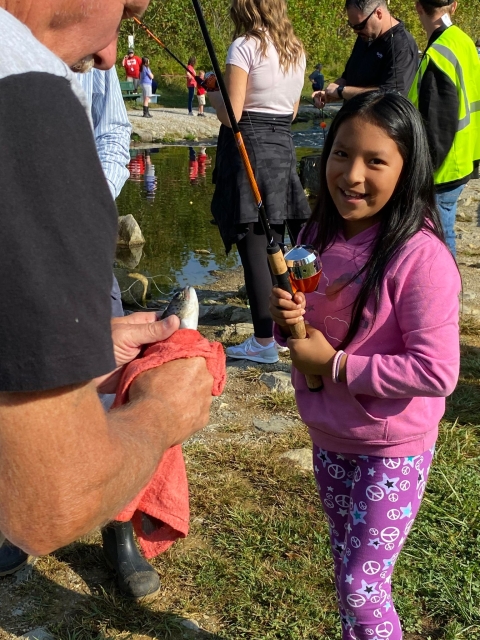In 2023 the National Fish Hatchery System raised and stocked more than 120 million fish and aquatic wildlife for conservation! Since 1872, national fish hatcheries have been raising fish and aquatic wildlife to improve sustainable recreational fishing, support fisheries that have been impacted by a federal dam, recover federally listed threatened or endangered species, fulfil our Tribal Trust responsibilities, and prevent at-risk species from becoming endangered.
2023 National Fish Hatchery System Distribution Totals
126,906,208 – Fish and aquatic wildlife released by national fish hatcheries
- 126,610,524- Fish released by national fish hatcheries
- 296,000 - Aquatic wildlife released by national fish hatcheries
49,587,163 – Eggs transferred through the National Broodstock Program
Learn more about our fish stocking and distributions
- 2023 Fish Distribution Table
- Fish Stocking Service
- National Broodstock Program's Egg Distribution Service
Threatened and Endangered Species Recovery
In 2023, more than 20 million threatened or endangered fish and wildlife were raised on national fish hatcheries for eventual release into a natural setting or to protect the genetic diversity of the species.
20,531,076 – Federally listed animals released or transferred from a national fish hatchery
70 – Threatened or endangered species raised in national fish hatcheries
Recreational and Subsistence Fish Stocking Program
Many states and Tribes rely on the National Fish Hatchery System to stock lakes and rivers with fish for sustainable recreational fishing and to support fisheries that have been impacted by a federal dam. In 2023 national fish hatcheries raised 118 million sport fish to support recreational fisheries.
118,057,814 – Sport fish released to support recreational fisheries
For decades, the Fish and Aquatic Conservation program has partnered with Tribes to stock fish in Tribal waters and provide technical assistance for fish and wildlife resource management needs and on Tribal lands. We pursue these collaborative management efforts not just to fulfill our Tribal Trust responsibilities and to promote sustainable management of important Tribal fisheries and wildlife, but also to ensure the benefits of resource conservation are accessible to everyone.
20 – Million fish distributed to Tribal lands
57 – Tribes stocked with fish for recreational and subsistence fisheries
Recreation and Visitation at National Fish Hatcheries
In 2023, nearly a million people visited national fish hatcheries and conservation offices across the country. These visitors came to us to catch their first fish, welcome salmon returning upriver to spawn, and become more deeply engaged in conservation.
992,805 - Visitors to FAC facilities
188,981 - Participants in community-based recreation and education programs
27,985 - Youth engaged in aquatic resource education
Economic Impact of Boating and Fishing
Fishing and boating fund conservation, support local economies, and improve the physical, psychological, and social health of everyone. According to the most recent National Survey of Hunting and Fishing, fishing and boating are an important cultural and economic driver across the country.
39.9 - Million people over 16 went fishing
$99.4 - Billion spent by anglers on fishing-related expenses
The National Fish Hatchery System and the Fish and Aquatic Conservation Program
The National Fish Hatchery System is one part of the U.S. Fish and Wildlife Service’s broader efforts to protect and restore freshwater fisheries and freshwater habitats. Fifty-one Fish and Wildlife Conservation Offices strategically located across the country work with a broad range of partners to recover and restore some of the nation’s most iconic fish, wildlife, and their habitats.
In additional to our hatcheries and conservation offices, 13 applied science facilities are advancing the fields of genetics, physiology, pathology, and nutrition. Our Fish Health and Fish Technology Centers and the Aquatic Animal Drug Partnership Program play leading roles in the recovery of endangered, threatened, and declining fish stocks, improving fish hatchery culture technology, and maintaining genetically important populations to protect future biodiversity.
- 70 National Fish Hatcheries
- 51 Fish and Wildlife Conservation Offices
- 7 Fish Technology Centers
- 6 Fish Health Centers
- 1 Historic National Fish Hatchery
- National Fish & Aquatic Conservation Archives
This is not an authoritative data set. Data is updated periodically and this page may not include the most recent information. All data is accurate as of January 2024.





